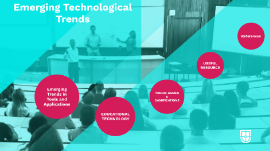Trends Presentation
Transcript: Emerging Technological Trends Emerging Trends in Tools and Applications It is important to stay informed on the ever changing technologies that have an impact on education. Today we will look at current trends in tools and applications. Emerging Trends in Tools and Applications EDUCATIONAL TECHNOLOGY Emerging Trends EDUCATIONAL TECHNOLOGY HARDWARE, SOFTWARE, & SYSTEM DEVELOPMENT Trends in Hardware, Software, and System Development Trend #1 : Ubiquitous Mobile Computing Trend #2: More Sources of Open Content Trend #3: Massive Open Online Courses (MOOCs) Trend #4: Increased e-book/e-text presence Trend #5: Tablet Computing Trend #6: Augmented Reality Systems Trend #7: Wearable Technologies Trend #8: Gesture-Based Computing Trend #9: Games and Gamifications Trend #10: Learning Analytics Trend #11: 3D Printing According to the annual report of the New Media Consortium’s (NMC) Horizon Project (Johnson, Adams Becker, Estrada, & Freeman, 2014; Johnson et al., 2013) the following trends have the potential to have great impact on our education and in turn our society. By incorporating the use of these trends, we can have a greater influence on learning in our classroom and help our students outside of the classroom as well (Roblyer 25). TRENDS IN EDUCATIONAL APPLICATIONS EDUCATIONAL APPLICATIONS Educational Applications Trends Creating an environement in which promotes learning is important and keeping up with trends that can aid in creating an environment that provides on demand instruction and feedback individualized for students plays a vital role in this. The following trends will help to provide just that. Trend #1: Flexible Learning Environments Trend #2: Personalized Learning Trend #3: New Instructional Models Trend #4: Reliance on Learning at a DIstance Trend #5: Increased Educational Options for Students with Disabilities 7 Trends TREND: GAMES & GAMIFICATIONS A trend that will I will look further into is Games and Gamifications TREND: GAMES & GAMIFICATIONS Importance: Games are a way to engage and motivate students. Gamification is a way of incorporporating motivational aspects of games such as badges awarded for success. By providing rewards for acchievement and increasing student intersest, the goal is to increase time spent on learning. Why include? USEFUL RESOURCE Today we will look at a resource that incorporates the Gamification aspect to increase engagment and motivation but is also a great tool for instruction. USEFUL RESOURCE KHAN ACADEMY KHAN ACADEMY Khan Academy is an online eduactional resource that contains practice for particular skills/tasks for many content areas. As students practice skils, they are provided with hints on problems if needed, instructional videos for additional support, engagment rewards for students, and progress monitoring that allows teachers to view class activitiy and achievment. https://www.khanacademy.org/ In Khan Academy teachers can set up classes so they can create tasks and monitor progress Setting Up a Class It is free to register and once you have registered you can "add children" for your classes under your profile. Under your profile, a teacher can view student progress. You are able to see videos students are watching, hints they have used, class statistics, badges and awards earned, and other activity. Profile The badges tab allows you to view all the badges your class has achieved. You can view mastery and how many questions are being successfully answered. Badges Badges The Progress tab provides a break down on what skills are mastered and what skills are not mastered. PROGRESS PROGRESS Khan Academy allows you to communicate with your students. You can ask questions and provide comments. It opens up communication between you and your students. DISCUSSION DISCUSSION Another tool that can be used is creating curriculum based projects for yours students. This is another great way for engagment and motiviation. You can chose from pre-made projects or create your own. PROJECTS PROJECTS This feature allows you to add "coaches" for your students. Coaches have access to your khan academy data. Another great tool is that you can allow parents to view their child's progress. This is a great way to keep parents up-to-date on how well their child is doing on particular skills. COACHES COACHES References References Roblyer, M. D. (2016). Integrating Educational Technology into Teaching, 7th Edition. Pearson, 20150130. VitalBook file. Khan Academy (2017). Retrieved May 21, 2017 from https://www.khanacademy.org/

















